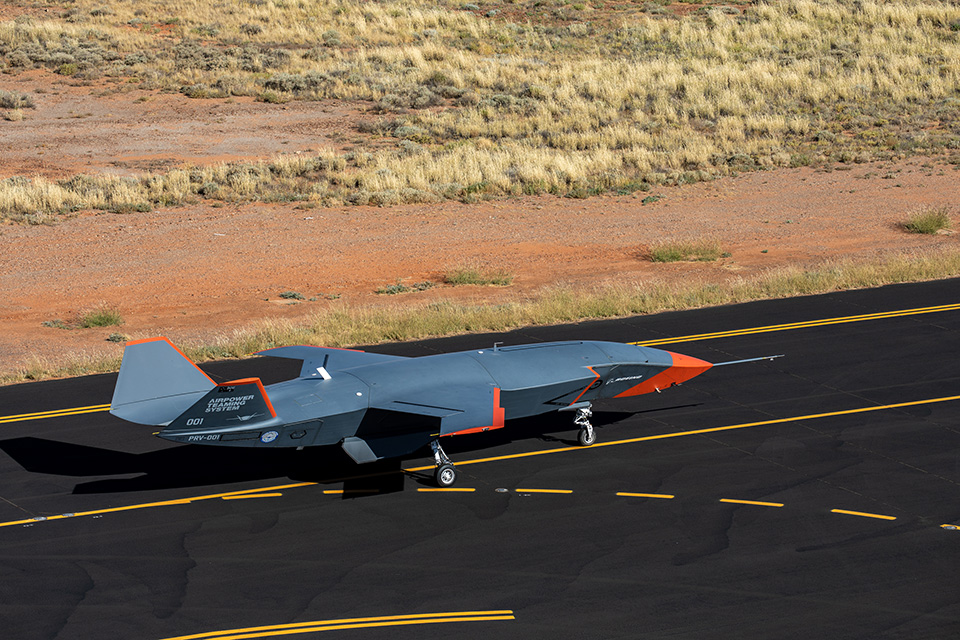The US Air Force is pursuing its Next Generation Air Dominance (NGAD) program on a war footing. The program will feature loyal wingman drones and other adjunct aircraft that will team with the USAF’s manned fifth and sixth-generation fighters.
Against that backdrop, the Boeing MQ-28 Ghost Bat drone developed by the company’s subsidiary in Australia has been approved for use by the Pentagon for research and development purposes in collaboration with the US Air Force, according to Breaking Defense.
The revelation comes after the Royal Australian Air Force’s Air Marshal Robert Chipman and the Chief of Staff of the US Air Force, Gen. Charles Q. Brown, signed a new agreement to further the existing partnership between the two services, according to a recent Air Force announcement.
The Office of the Undersecretary of Defense for Research and Engineering oversaw the purchase. Whether the OUSD (R&E) and the Air Force have only received one MQ-28 or a single ghost bat “system” that consists of numerous airframes has not been specified as of this point.

The Air Force did reveal in August that Boeing had entered the country with at least one MQ-28 Ghost Bat for unknown purposes. There have since been speculations that the MQ-28 Ghost Bat drone could be integrated into the Next Generation Air Dominance (NGAD) family of systems.
Air Marshal Robert Chipman, the newly appointed head of the Royal Australian Air Force, hosted the US Air Force Secretary Frank Kendall in Canberra on 22 August. At the time, Kendall revealed that the US and Australia actively sought to collaborate on unmanned platforms, such as the Boeing MQ-28 Ghost Bat drone.
The MQ-28 Ghost Bat’ Loyal Wingman’ aircraft uses artificial intelligence to assist both manned and unmanned aircraft in mid-flight. The advanced unmanned system will be able to operate alongside existing manned aircraft and will execute teaming operations using artificial intelligence (AI).
A lil baby scooplet: It turns out that the US Air Force is soon going to start experimenting with the MQ-28 Ghost Bat developed by Boeing for the Royal Australian Air Force. (Air Force Secretary Frank Kendall has been hinting this was in the works…)https://t.co/YSV49JZyDw
— Valerie Insinna (@ValerieInsinna) October 5, 2022
The drone is 11.7 meters long and 7.3 meters wide. The range of this aircraft is more than 2,000 kilometers, and it can fly at subsonic speeds. The AI-assisted autonomous drone will be able to fly by itself while keeping a safe distance from manned aircraft.
It will have sensor packages allowing it to carry out tactical early warning and intelligence, surveillance, and reconnaissance (ISR) missions. The drone, a loyal wingman design, and the concept have been developed by Boeing in collaboration with the Royal Australian Air Force.
The American acquisition of this drone is significant as USAF Secretary Frank Kendall announced last month that the service could float a contest for the drone counterpart of the sixth-generation manned fighter as early as fiscal 2024, as previously reported by EurAsian Times.
However, the USAF is yet to specify what will be the exact role of the Ghost Bat drone.
Ghost Bat To Assist Manned-Unmanned Teaming?
The USAF Secretary Frank Kendall said last month the Air Force was having “early conversations” with industry players as it develops an acquisition strategy for a program known as Collaborative Combat Aircraft (CCA).
The CCA program strives to field one or more unmanned aircraft types as a component of the service’s Next Generation Air Dominance (NGAD) family of systems.
To that end, the USAF is looking for an adjunct loyal wingman drone. Kendall had earlier stated that the Ghost Bat might be a useful “risk-reduction mechanism” to assist the Next Generation Air Dominance (NGAD) program.
CCA is only one of many parts of the larger NGAD program, which also entails the creation of a sixth-generation stealthy crewed combat jet, as well as new weaponry, sensors, networking and battle management capabilities, jet propulsion technology, and more.
Future CCAs would probably work in tandem with 4th and 5th-generation Air Force jets besides a next-gen stealthy fighter.
The Ghost Bat has long seemed to be Boeing’s most direct route into the CCA market. It was originally built for the Royal Australian Air Force’s (RAAF) Airpower Teaming System (ATS) loyal wingman drone program and made its first flight in 2021.
As the Air Force draws closer to launching a formal CCA competition, which the military has stated it anticipates to begin in the 2024 Fiscal Year, more information on how the MQ-28 is being used may become available.
Secretary Kendall has also stated that this program will probably be highly classified and called it a “black program.”
Besides this, General Atomics, Lockheed Martin, and Northrop Grumman have already developed plans for families of unmanned aircraft and accompanying technological advancements that are either officially or implicitly intended to satisfy the Air Force’s still-evolving CCA.
The acquisition of the Ghost Bat also underscores the growing military cooperation between the United States and Australia. The two are already working on building a nuclear submarine for Canberra with technology transfer from the US Navy.
Not just that, the two partners, along with the United Kingdom, announced earlier that they would work together on a hypersonic missile.
As this cooperation strengthens, Australia’s home-grown loyal wingman drone being tested and used by the Pentagon and the US Air Force would bolster ties. However, the role of the Ghost Bat is still more or less classified.
- Contact the author at sakshi.tiwari9555@gmail.com
- Follow EurAsian Times on Google News




